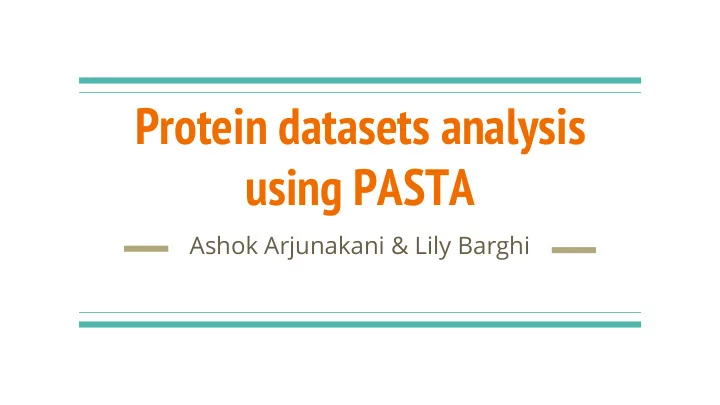

Protein datasets analysis using PASTA Ashok Arjunakani & Lily Barghi
PASTA Algorithm 1. Obtain initial alignment 2. Decompose Tree into subsets Mirarab et al (2015)
PASTA Algorithm Subsets aligned and merged together to create multiple sequence 3. alignment Mirarab et al (2015)
PASTA Algorithm 4. Use Maximum Likelihood tree to compute tree estimation Mirarab et al (2015)
Our Project Use the different multiple sequence alignment methods and tree ● estimation methods found in PASTA to assess which collection of methods causes the best accuracy and efficiency Using aligned Protein Sequences ● Generated alignment and tree will be compared to reference tree ● and alignment. Reference tree is generated by using RAxML ○
Protein Datasets 1. BlaR1 peptidase: 2,747 sequences a. http://merops.sanger.ac.uk/cgi-bin/merops.cgi?id=M56 2. Ulp1 peptidase: 5,954 sequences a. http://merops.sanger.ac.uk/cgi-bin/famsum?family=C48 3. Amidophosphoribosyltransferase precursor: 11,342 sequences a. http://merops.sanger.ac.uk/cgi-bin/famsum?family=C44 4. Dipeptidyl-peptidase VI: 13,452 sequences a. http://merops.sanger.ac.uk/cgi-bin/famsum?family=C40 5. Pepsin A: 16,022 sequences a. http://merops.sanger.ac.uk/cgi-bin/famsum?family=A1
Checking Accuracy of MSA & Trees FastSP: checks accuracy of multiple sequence alignment (MSA) ● based on SPFN SPFN: comparison to reference alignment to see how many ○ amino acids are missing in estimated sequence alignment Reference trees will be created using RAxML and compared using ● Robinson-Foulds (RF) distance from Dendropy Script from Erin Molloy’s presentation in CS466 ○ RF distance: number of edges two trees do not share with ○ each other
Bibliography [ 1] Mirarab, Siavash, Nam Nguyen, Sheng Guo, Li-San Wang, Junhyong Kim, and Tandy Warnow. "PASTA: Ultra-Large Multiple Sequence Alignment for Nucleotide and Amino-Acid Sequences." Journal of Computational Biology 22.5 (2015): 377-86. Web. Apr. 2017. [2] Walle, I. Van, I. Lasters, and L. Wyns. "SABmark--a benchmark for sequence alignment that covers the entire known fold space." Bioinformatics 21.7 (2004): 1267-268. Web. Apr. 2017. [3] Edgar, R. C. "MSA benchmark collection." Drive5 . N.p., n.d. Web. Apr. 2017. [4] Thompson, Julie D., Patrice Koehl, Raymond Ripp, and Olivier Poch. "BAliBASE 3.0: Latest developments of the multiple sequence alignment benchmark." Proteins: Structure, Function, and Bioinformatics 61.1 (2005): 127-36. Web. Apr. 2017.
Bibliography continued [5] Le, Si Quang, Nicolas Lartillot, and Olivier Gascuel. “Phylogenetic Mixture Models for Proteins.” Philosophical Transactions of the Royal Society B: Biological Sciences 363.1512 (2008): 3965–3976. PMC . Web. Apr. 2017. [6] Mirarab, S., and T. Warnow. "FASTSP: linear time calculation of alignment accuracy." Bioinformatics 27.23 (2011): 3250-258. Web. Apr. 2017. [7] Warnow, Tandy. Computational Phylogenetics An introduction to designing methods for phylogeny estimation. N.p.: n.p., n.d. Web [8] Molloy, Erin. "Compare_trees.py." GitHub . CS466, n.d. Web. Apr. 2017. [9] Rawlings, Neil D., Alan J. Barrett, and Robert Finn. "Twenty years of the MEROPS database of proteolytic enzymes, their substrates and inhibitors." Nucleic Acids Research 44.D1 (2015): n. pag. Web. 13 Apr. 2017.
Recommend
More recommend